Canine Companions — Puppies for Everyone
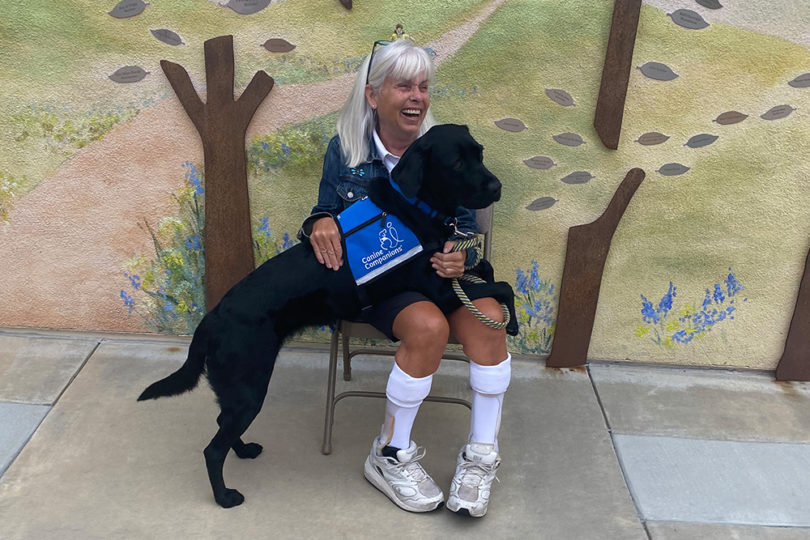
Navigating Life’s Transitions with Canine Companions
Puppies for everyone! I don’t know about you, but Christmas shopping for my family would be over in a flash if I could just buy everyone a puppy. In November I had several reminders of the impact of dogs on our lives, the connection they make with people, and how a visitor with a wagging tail lightens everyone’s day. In this edition of Navigating Life’s Transitions, we will be looking at the effects of trained service and facility dogs on seniors. We will be looking behind the curtain on one of the preeminent service dog organizations in the country, Canine Companions.
Recently, as my wife and I prepared to travel to Canine Companions’ (CC) Training Center in Oceanside, California, for two weeks of Team Training, I had good flashbacks: the amazing connection Marcie had had with her previous service dogs, the impact of training dogs I’d witnessed on recipients and their families, how the introduction of a dog changed everything for any organization receiving a facility job, as well as several personal experiences Marcie and I had had over the last 15 years. These flashbacks also raised some recurring questions in my mind: How do people get these highly trained service or facility dogs from Canine Companions at absolutely no cost? What exactly is Team Training, and why is it two weeks long and so challenging? Finally, this article will discuss the how and why regarding the dramatic effect these exceptional dogs have on seniors, senior communities, staff, and families. I’ll also provide a few ways you can be involved.
What I’ve Seen with Seniors and Dogs
Research shows that all of us have altered brain activity when we interact with pets in general. What happens when most of us focus on a dog like this photo is our brains release dopamine, the “feel-good” hormone. I never had any doubt about the “feel good” piece, whether it was pets in my office, their effect in our home and family, or Fredo and Mom’s special place alone without another soul at the moment—there have always been lots of “feel good” going on!
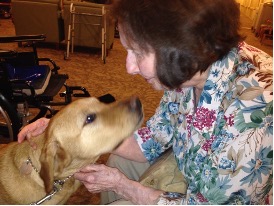
I still get chills looking at this photo of my mom. Please excuse the poor picture quality, as I never imagined in 2013, just before her death, that I’d ever be sharing this story or this photo. At this point, Mom’s dementia had robbed her of knowing my wife or myself. But when Fredo showed up, she knew exactly what to do. Mom could remember the universal “Lap” or “Visit” command, and Fredo remembered loving on Mom. You should be thankful, too, that this is electronic so you’ll never see the tears I’ve shed remembering these times. Even in this old picture, you see Fredo and my mom’s connection. Fredo knew immediately she was a dog person. Mom’s years were measured by pets, litters of puppies, and her ability to captivate or, maybe better, monopolize a dog entering a room.
Kenny’s Story
At Marcie’s Team Training this past November, I also had the distinct pleasure of meeting Kenny’s person, Rich Mayfield. Rich could see the connection humans have with dogs in his own work as an interfaith chaplain at a senior community, and over a decade ago, he boldly took on the application process for a facility dog from Canine Companions. We will talk more about the application process in a moment. Kenny like most of Canine Companions’ dogs is a Lab Golden mix. With Kenny at his side, Rich graced the halls, apartments, bedsides, and meeting rooms of Mt. San Antonio Gardens in Pomona, California, up until last year when Kenny retired. Rich hadn’t himself retired, but this time he had returned to Canine Companions to receive a service dog of his own. Rich understood that a service dog would further his personal mission and purpose. But unlike Kenny, who was a facility dog for all, his new dog would work directly focused on him versus the community at large. Rich’s work continues but now with Logo, another exceptional dog who will aid Rich directly with tasks he needs assistance with.
As a result of the giant commitment of Team Training, Rich and I agreed to share Kenny’s story after he and Marcie completed training and graduated with their new service dogs. When we met via Zoom, Rich explained, “The Gardens has 550 residents and is a Continuing Care Community, which means there are four different areas of residence: Independent, Assisted Living, Skilled Nursing, and Memory Care.” As an interfaith chaplain, Rich “worked across all four levels” with Kenny, but as Rich further expressed, “Kenny was most effective in Memory Care and Skilled Nursing.”
Rich recalled Kenny’s “ability to quietly sit and allow others to pet and talk with him for long periods serving the needs of many of our more impaired residents.” Rich said, “Many would stop by my office, which is situated near a busy sidewalk, for some ‘Kenny time.’” These encounters gave Rich a natural entry into the lives of the residents, including both their problems and successes. Kenny’s calming influence reached staff and residents alike. Even Kenny’s presence at staff meetings reduced stress and anxiety, as he offered his own cues, such as downward dog stretches or large yawns for levity or perhaps just expressing the need for a change of tenor in the meeting.
Rich graciously shared some of Kenny’s most amazing moments. In one instance, visiting a room with Kenny, he described, “A 98-year-old woman is into her last few hours of life. I drop by with Kenny, and he calmly takes a position by the bed and very near the woman whose head is resting on a pillow. For a very long time . . . I wish I would have clocked it! . . . Kenny put his head on her pillow and patiently held the position. I have no idea if the woman was even aware of the gesture, but for the staff and family present it was both beautiful and powerful.”
On more than one occasion, according to Rich, “Kenny’s trainer, me, was occasionally asked to bring Kenny along to a memorial or funeral service for a resident who had enjoyed Kenny’s presence while he or she was alive. The pleasure emanating from the eyes and hearts of the attendees was indicative of the joy these dogs can bring to others even in the saddest of times.” Often, Rich’s own benediction at the end of an event would trigger Kenny to rise and begin his exiting exercises or perhaps rituals doing his downward dogs or other stretches. Our trainers in California repeated the same refrain, almost with a peculiar cadence, over and over again during training: “Dogs live in the moment.” Perhaps that is what makes them so distinct from us humans: a dog is always present, but I can be a million miles, days, or years away from what’s going on right in front of me. Kenny and Fredo have the secret power of always being fully present in the moment.
Canine Companions by the Numbers
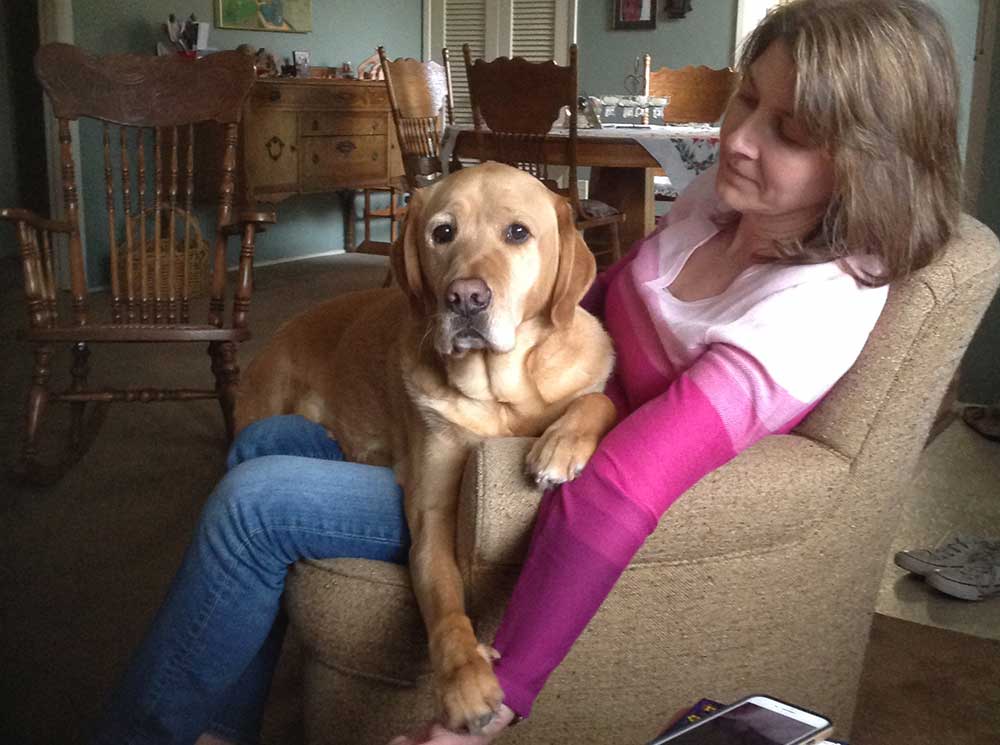
If Fredo’s and Kenny’s were the only stories you heard about Canine Companions, the organization’s tagline would still be true: “Exceptional Dogs for Exceptional People.” But their mission and reach go way beyond giving away puppies, and every day their exceptional dogs grow up to be service dogs and facility dogs, like Fredo and Kenny, respectively. But they also train hearing dogs, skilled companion dogs for children and adults with disabilities, and specially trained dogs working with veterans suffering from PTSD.
Since Canine Companions started in 1975, they have placed over 7,020 teams, and this year by October they have seen 309 teams graduate with another 103 expected by year-end. Actively right now in the United States, Canine Companions supports 2,634 teams, each comprised of a dog and a person, who are living more richly because we all do better in teams. Considering merely facility dogs like Kenny today, there are 409 teams working with another 59 expected to graduate by year-end.
When I spoke with Janine Konopelski, Vice President of Marketing and Advocacy for Canine Companions, she shared this: “Facility dogs are trained in more than 45 tasks to assist clients as an integrated therapeutic modality. Specially trained to adjust their speed to match a client, facility dogs keep seniors moving longer by providing safe and effective motivation. Facility dogs also work with seniors on memory and speech by performing specific tasks for the client in response to their commands, including retrieving items. Clients work with facility dogs to play games that also improve motor skills, focusing on the facility dog and games instead of the potentially difficult therapy.”
Canine Companions breeds and thoroughly controls their breeding program and hence all the puppies being raised. Thus far in 2021, this has resulted in an astonishing 602 puppies approximately a year old to entered the advanced training phase of their lives with another 561 puppies being born (don’t forget to follow the link here or at the end of this article to get your own 2022 Puppy Calendar.
In November, while at graduation for Marcie and Rich, 45 new puppies between one and two years old arrived at Oceanside’s training and kennel center. They were beginning their advanced training with the goal of becoming what CC hopes to call another class of exceptional dogs for exceptional people. Besides Canine Companions’ amazing training staff, Team Training facilities, facility, and kennel staff they have a network of over 1,000 puppy raisers. Fredo, Kenny, Tabatha, and Logo were all selflessly raised by a puppy raiser from six to eight weeks old until about one year old.
Puppy raisers passionately provide the dog with socialization, skills training for specific tasks, all areas of care general care, pampering, and vet and health care until they return the dogs to Canine Companions. With their puppy raiser, each dog experiences both the rigors and freedoms of service dogs, air travel, and trips to the grocery, but also daily training and exercise sessions. Once a puppy raiser returns a dog to Canine Companions for advanced training, several things occur. First, every puppy raiser is so highly invested in the process, they follow every dog they raise for the program; many of these amazing people are repeat offenders, rendering their selfless service with 20 or more dogs over several years. Both Logo, Rich’s new service dog, and Tabatha, Marcie’s successor dog, had their puppy raiser attend graduation, eager to see how their puppy had advanced; the puppy raiser’s greatest reward is seeing their dog teamed with a graduate for service.
Team Training — A Convergence Experience
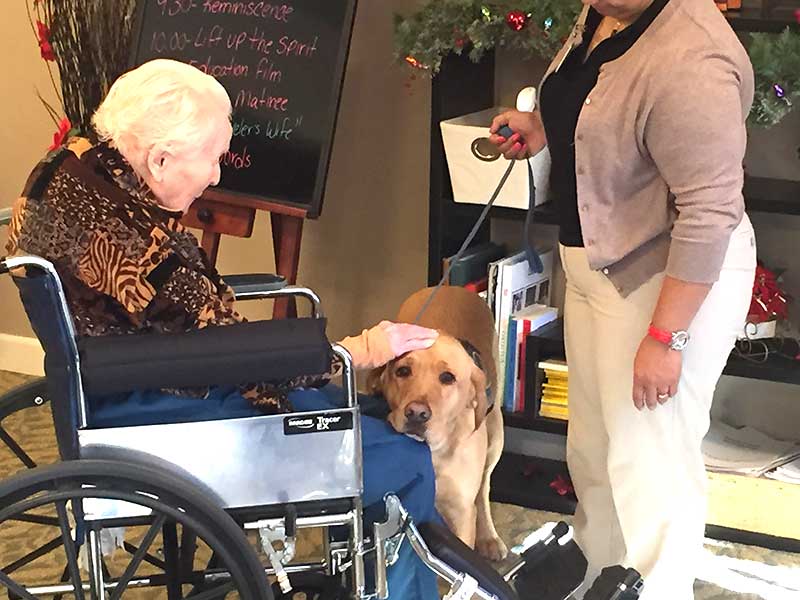
Team Training takes place in one of the six Canine Companions training centers in the nation. Marcie has attended Team Training twice in Ohio, which just opened a new center with state-of-the-art training, kennel, offices, and recipient housing in October of 2020 in New Albany. Each applicant, regardless of his or her specific need, goes through a rigorous application process. As in the case of Rich and Marcie, the period from submitting an application to receiving a dog can be a year or more. In Marcie’s situation, her application was for a successor dog. A successor’s dog, like Marcie’s Tabatha, can either replace a retired or deceased service dog. Fredo had passed away in October 2020, but in Rich and Logo’s case, Kenny had reached retirement age as a facility dog prior to Rich applying for his service dog. Kenny is now living the more normal leisure life of dogs at Rich’s home.
Meanwhile, like the 45 dogs that arrived while we were at graduation, each enters advanced training where the rudimentary 30 to 40 commands are broadened and reinforced so that repeatability approaches perfection and command knowledge can be 45 or more commands. This also means training with rabbits, cats, or other distractions being introduced, yummy kibbles getting dropped on the floor, or the Dyson running while the dog is asked to complete a task. This is preparation for real-life so a recipient who has problems walking will never be knocked over by a startled dog; all CC’s dogs must not jerk to get the kibble or food a toddler throws but instead stay fully present with the human member of their team. The puppy’s attention is turned from advanced training to preparation for Team Training with over six months of work ahead of them with the professional trainers of Canine Companions.
While these puppies are moving through advanced training with CC Professional Trainers the recipients like Rich or Marcie and their classmates, are being interviewed, watched with the dogs moving around if they have one or with a person acting like a dog; that was one of my roles. Then the potential recipients are asked questions to demonstrate how they work with a dog so that the trainers can vigilantly determine who might be a good match with whom, what dog-human team will offer the highest chance of success. Is the person assertive or passive, slow, fast, or jerky in movement, loud or soft-voiced, clear speaking, or garbled? What limitations exist that can be overcome or mitigated with a skilled service dog? How will the human react if the dog is naughty?
Remember the movie Up where Doug the talking dog suddenly shifts focus to stage left and yells, “Squirrel!”? Well just like Doug, real dogs always live in the moment too and respond to sudden movements we humans have learned to typically ignore; knowing how a team’s response to this kind of stimulus will be vital to success and safety. Finally, the incredible trainers play through infinitely more variables, getting to know each dog’s unique personality, movements, and styles to consider what human needs can be most effectively met by which dog.
Sometime later, a recipient is told first of being approved to receive a dog and in time when an open spot in the training cycle will be available. For the majority of graduates, this wait could be in excess of a year regardless of prior circumstances with service dogs or CC. However, since successor recipients have a potentially more imminent need, not unlike a trapeze artist they are often operating without a net having lost the benefit, safety, and freedom that a service dog provides. One can hardly imagine, after years of success with a service dog performing unique and specific tasks for you, how life is altered once that relationship has ended. Now, for example, going to the mall by oneself causes questions to flood in, such as how will I open that door, or who will pick up my car keys if I drop them in the parking lot?
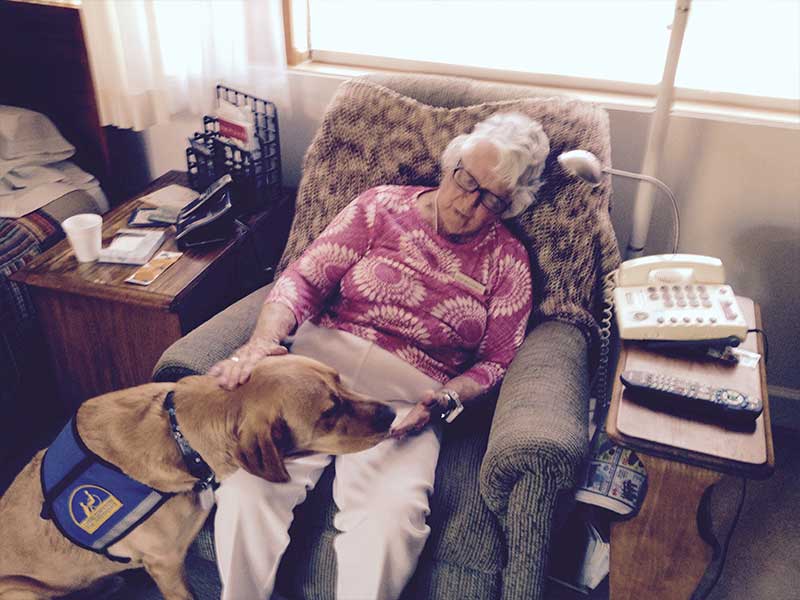
During Team Training, classes started on Monday at 9:00 a.m., went to 4:00 p.m. each day with homework and assigned dog duties every night. Here is where all the work of puppy raisers, staff, trainers working on Advanced Training, recipients and their families hope for—the convergence of humans and dogs with the metamorphosis and bonding becoming “exceptional dogs for exceptional people.” For myself, it was the honor of witnessing the daily journey of Marcie and Tabatha becoming a powerful team.
Arriving at Canine Companions for two weeks, aspirations are high, wanting this future state, a powerful team; so intentionally and purposefully CC’s Professional Trainers shifting their focus from dogs with an eye toward the human/dog team to real-life teams. The support staff on campus are busy keeping dorms clean, getting lunches for two weeks for everyone in the class, and feeding, grooming, playing, walking, and cleaning up after 50 dogs every day. Just in case you think this is glamping at a pet palace or like some sort of all-inclusive Sandals resort, first, there is no towel service or wake-up calls. You can get your own towels, which is really the only heavy lifting you’ll do for two weeks, and the alarm clock is superfluous because each morning at 5:30 a.m. the alarm instead is 50 dogs watching as food is scientifically measured out prior to their breakfast. Lunch and a mid-day break are both provided, welcomed, and needed for dogs and humans alike.
Class sessions cover animal behavior—remember, dogs are always in the moment—grooming, command structure, which is shorthand for how to train the dog correctly while not untraining your dog. Each evening is followed by homework and videos, and week one progresses while you work with the pre-match favorite of the instructors. Besides remembering that dogs “live in the moment,” we are all encouraged each day to “trust the process,” not in a cultish sort of way but more as the secret sauce with Canine Companions. This doesn’t end up being a secret; quickly we all learn, the instructor’s ability to size up humans and dogs, their expertise, passion, and compassion are all factored into coming up with potential teams. By day 3 the secret sauce is out of the bottle. It usually takes a few more days before words like “genius” and “I see” become commonplace among recipients and their families, out of respect for the process and the instructors’ wisdom.
Classes usually have 10 to 15 dogs who filter in and out, while instructors are confirming which will be most compatible with the humans present. This is gauged by practice sessions learning commands and test-driving teams. Interestingly, Rich and Marcie for example both had opportunities to work with Logo plus a few other dogs. At the end of 8 to 12 hours of these exercises, Rich was matched with Logo, while Marcie and Tabatha were matched. Spoiler alert, Tabatha was perfect for Marcie; her instructor knew that before we even arrived and soon we were all believers—Tabatha, Marcie, myself, and to this day everyone who meets Tabatha.
Each Saturday during Team Training, there is still class, but you get off for a half-day and off all day on Sunday. This is bonding and working time for the teams. Spouses, parents, or friends generally accompany recipients to support them; think basic training for people who are stretched emotionally, in a new environment completing four of the five phases of team formation: forming, storming, norming, and performing. Hopefully, the fourth phase is artfully navigated by the trainers in week 2, working often individually with the teams or out in the real-world doing field trips.
For Marcie’s training, this time around we were at Oceanside California’s Canine Companions campus. The funding from benefactors was so generous that the campus includes the dorm rooms, which are designed for folks with disabilities, having bedrooms and bathrooms that are highly adaptive. Located next to the dorms is a shared great room for 25 and kitchens, stoves, refrigerators, freezers, and pantries all intended for large groups. Each day the class walks through activities of daily life in the dorms and shared spaces, returning to the classroom and grounds for dog and human needs. In this way, everyone has the joy and satisfaction of hard work and of trusting the process and in the end reaffirming the Canine Companions motto, “Exceptional Dogs for Exceptional People.”
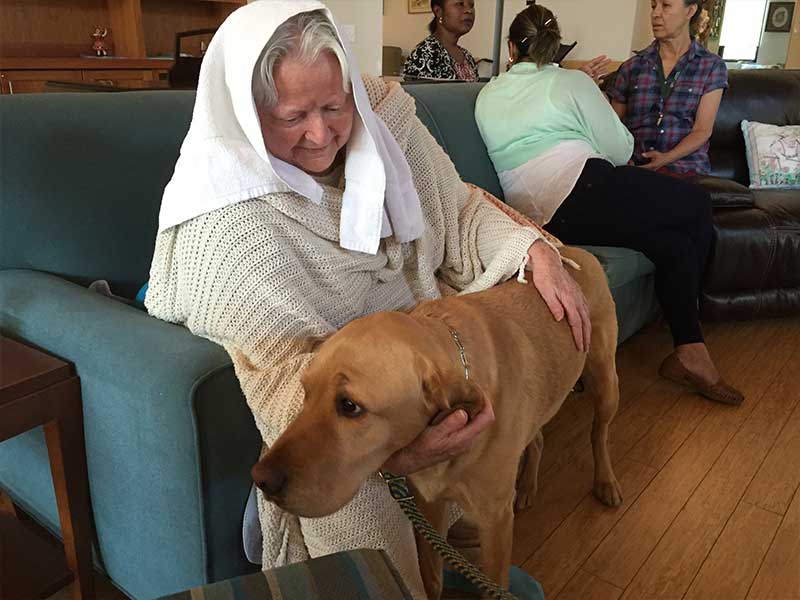
Senior Communities, Staff, and Executive Delivering Hope
While puppies are cute and nearly everyone adores them, everyone also loves “well-behaved” dogs. During our visits to Mom, as I said, when she no longer remembered me or Marcie, Fredo’s presence always changed the moment.
Many friends and colleagues in the Denver senior sector see these connections between dogs and residents and bring their dogs to work. I love that and think it is sensational, but when the COVID pandemic happened and the associated isolation for so many seniors first there was a deeper sense of loss and none of my pets, even two sight service dogs who were released lacked the therapeutic connection between handler, dog and resident. Senior residents often need both, just a fantastic pet dog to be loving on but also the therapeutic piece that Kenny provided as Janine Konopelski mentioned above. So we need more Kennys and Fredos, and we need more people like Rich who are willing to better serve seniors with the help of a universal translator of the language of love, a dog. We need the connection my mom was feeling with Fredo and the look in the eyes Marcie receives when she locks eyes with Tabatha.
Truthfully, my hope is that you can become even more “exceptional” by maybe selfless being a puppy raiser for Canine Companions. I have family members who have done this simply because of Marcie’s story. Your exceptional next step could be becoming a recipient for either a service dog or a facility dog, similar to Rich’s work with seniors. Perhaps you’ll be like Charles Schultz, the Peanuts author who made significant denotations supporting Canine Companion Oceanside Ca. Campus. Your situation may mean you are moved to support another service dog organization or become a financial supporter of Canine Companions, or perhaps support the cause by buying a puppy calendar of your own. Let me know what your next step is, if you’re so inclined! Happy puppies, happy holidays, and blessings for a wondrous new year in 2022!
Rick Adler is the founder of Senior Placement of Denver; he’s also a senior, a part-time caretaker, and a frequent dog walker. You can find me at Senior Placement of Denver or contact me at [email protected].
